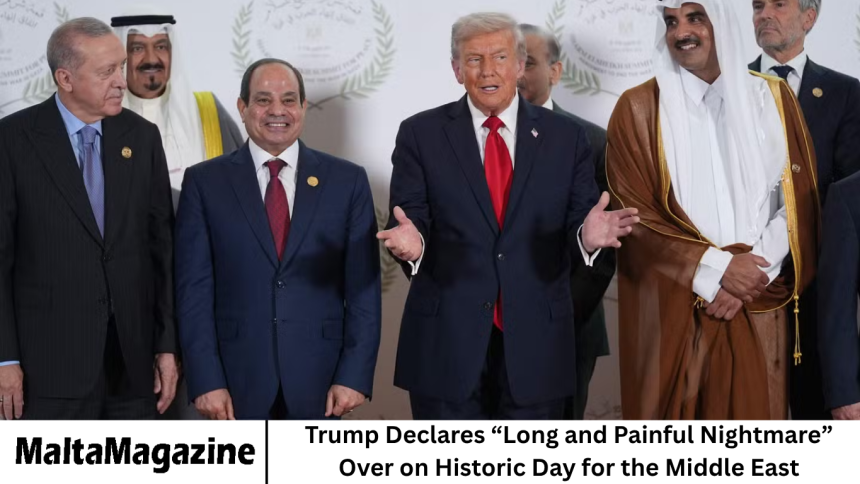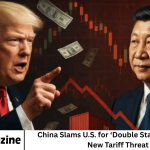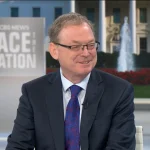It was a moment charged with symbolism, spectacle, and sweeping rhetoric — one that former U.S. President Donald J. Trump framed as the culmination of decades of struggle and diplomacy. Standing at a podium draped in American flags and flanked by foreign dignitaries.
- A Historic Declaration: The Setting and the Moment
- The Roots of Conflict and the Quest for Peace
- The Abraham Accords: Foundation of Trump’s Middle East Policy
- Reactions Across the Middle East
- Global Reactions and U.S. Political Impact
- Economic Implications: The Promise of Prosperity
- The Political Strategy Behind Trump’s Declaration
- Long-Term Challenges and Unresolved Issues
- Trump’s Legacy in Middle East Diplomacy
- A Symbolic Moment or a Genuine Turning Point?
- The Road Ahead: Maintaining the Momentum
- Frequently Asked Question
- Conclusion
For a region long defined by turmoil — from wars and terrorism to broken peace talks and shattered trust — Trump’s statement resonated as both a bold proclamation and a challenge to history itself. The Middle East, a land where ancient rivalries and modern geopolitics collide, has rarely seen a day untouched by tension.
While critics, analysts, and world leaders continue to dissect the meaning and implications of Trump’s bold declaration, the event marks another chapter in his self-described legacy of reshaping America’s role in the world and redefining the geopolitical balance in the Middle East.
More Read: China Slams U.S. for ‘Double Standards’ Amid New Tariff Threat
A Historic Declaration: The Setting and the Moment
The announcement came during a high-profile ceremony attended by U.S. officials, diplomats, and representatives from key Middle Eastern nations. The setting was grand — with flags fluttering, cameras flashing, and Trump standing confidently behind a podium emblazoned with the presidential seal.
Trump’s tone was triumphant as he proclaimed the end of what he called “decades of suffering, hatred, and conflict.” He praised the courage of Middle Eastern nations that had come forward to “choose peace over endless war” and vowed that this new phase would “change the course of history forever.”
“This day will be remembered as the moment when a region once torn apart by divisions began to unite,” Trump said. “The long and painful nightmare of conflict is over — a new dawn of peace and prosperity is rising.”
The Roots of Conflict and the Quest for Peace
To fully understand the weight of Trump’s declaration, it is essential to revisit the deep historical wounds that have long defined the Middle East.
For over seven decades, the region has been plagued by wars, territorial disputes, religious tensions, and political rivalries. The Israeli-Palestinian conflict, in particular, has been one of the most persistent and emotionally charged issues, shaping not only regional politics but also global diplomacy.
Various U.S. presidents have attempted to broker peace in the Middle East. From Jimmy Carter’s Camp David Accords (1978) to Bill Clinton’s Oslo Agreements (1993) and George W. Bush’s Roadmap for Peace, each administration sought to mediate negotiations — yet none achieved lasting stability.
Trump’s approach, however, diverged sharply from his predecessors. He pursued what his administration termed “peace through strength,” prioritizing direct bilateral deals and economic incentives over traditional multilateral negotiations.
The Abraham Accords: Foundation of Trump’s Middle East Policy
At the heart of Trump’s proclamation was the Abraham Accords, a series of normalization agreements signed between Israel and several Arab nations — including the United Arab Emirates (UAE), Bahrain, Morocco, and Sudan.
The accords, signed in 2020, marked a major diplomatic breakthrough. They established formal relations between Israel and these countries for the first time in history, paving the way for economic cooperation, tourism, cultural exchange, and security coordination.
For Trump, these deals symbolized the culmination of a vision — one that rejected the notion that Middle Eastern peace was impossible without resolving the Israeli-Palestinian issue first.
“Today we prove that peace is not only possible, it is inevitable,” Trump said at the original signing ceremony. “People of different faiths and backgrounds are coming together — Jews, Muslims, and Christians — to build a future of hope.”
The accords reshaped diplomatic ties, creating new opportunities for trade, technology partnerships, and defense collaboration. Israeli companies began working with Gulf firms, and direct flights between Tel Aviv and Abu Dhabi became a powerful symbol of the region’s new reality.
Reactions Across the Middle East
Trump’s declaration was met with mixed reactions across the Middle East — a blend of optimism, skepticism, and caution.
Supporters’ View
Supporters hailed the agreements as a bold step toward regional stability. The UAE and Bahrain leadership described the peace deals as “historic acts of courage,” emphasizing the economic and security benefits of cooperation with Israel.
Morocco, too, celebrated its renewed diplomatic and cultural ties, noting the potential for tourism and technology investments. For these nations, normalization was not just about diplomacy — it was a strategic calculation.
Aligning with the U.S. and Israel strengthened their regional security, particularly against shared adversaries like Iran.
Critics’ View
However, other voices across the Arab world — especially within Palestine and Iran — viewed Trump’s declaration as premature and politically motivated.
Palestinian leaders denounced the agreements, calling them a “betrayal” of the Palestinian cause. They argued that no true peace could exist without addressing the fundamental issues of statehood, occupation, and human rights.
Iran, meanwhile, condemned the accords as a “dangerous alliance” that would “fuel division rather than peace.” Tehran accused the U.S. and its allies of using normalization as a way to isolate Iran and shift regional power dynamics.
Global Reactions and U.S. Political Impact
The international response to Trump’s declaration mirrored the divided nature of Middle Eastern politics.
Western Allies
Many Western nations cautiously welcomed the agreements. European leaders praised the accords for reducing tensions and opening new channels for cooperation, though they also stressed the need to continue pursuing a two-state solution for Israel and Palestine.
The United Kingdom and Germany highlighted the potential economic benefits, noting that stability in the Middle East could strengthen global energy security and trade.
U.S. Domestic Reaction
Within the United States, the declaration also sparked intense debate. Trump’s supporters celebrated it as proof of his foreign policy success, contrasting it with what they perceived as decades of failed diplomacy.
Republican lawmakers hailed the event as “a monumental step toward peace,” while many Democrats acknowledged the positive outcomes but questioned Trump’s approach to the Palestinian issue, arguing that sustainable peace requires inclusivity and dialogue.
Economic Implications: The Promise of Prosperity
Beyond diplomacy, the normalization agreements carried substantial economic potential.
Trade and Investment:
Israeli technology firms began exploring partnerships in cybersecurity, agriculture, and renewable energy with Gulf nations. The UAE, in turn, invested in Israeli innovation startups, creating a new economic corridor in the Middle East.
Tourism and Culture:
Direct flights between Tel Aviv, Dubai, and Manama brought waves of tourists eager to experience cross-cultural exchange. Kosher food restaurants appeared in the Gulf, and Jewish cultural centers reopened after decades.
Energy Cooperation:
Energy security became another cornerstone. Israel, with its natural gas reserves, began discussing energy exports and joint ventures with Arab partners, potentially reducing dependency on other global suppliers.
Defense Collaboration:
Defense and intelligence sharing increased significantly. With Iran viewed as a mutual threat, countries saw value in collective security arrangements, potentially laying the groundwork for a more coordinated regional defense strategy.
Trump celebrated these outcomes as evidence that his approach to diplomacy was working. “Peace brings prosperity,” he declared. “When nations trade, invest, and innovate together, they stop fighting.”
The Political Strategy Behind Trump’s Declaration
Trump’s statement that “the long and painful nightmare is over” was not only a diplomatic message — it was a political one. By the time of the announcement, Trump was positioning himself for a possible political comeback, framing his foreign policy record as evidence of strong leadership and results-driven diplomacy.
His team emphasized that under his administration, the Middle East saw fewer new wars, more alliances, and growing economic ties. His supporters often compared the Abraham Accords to major 20th-century peace deals, arguing that they achieved what decades of conventional diplomacy could not.
Critics, however, accused Trump of oversimplifying the situation and using the accords as a political tool. They pointed out that despite normalization between some Arab states and Israel, violence and instability continued in areas like Gaza, Yemen, and Syria.
Long-Term Challenges and Unresolved Issues
Despite Trump’s optimistic tone, analysts caution that peace in the Middle East remains fragile and conditional.
The Palestinian Question:
The core issue of Palestinian statehood remains unresolved. Without progress toward an independent Palestinian state, many experts warn that peace agreements may not fully address underlying tensions.
Iran’s Role:
Iran’s growing influence and nuclear ambitions continue to worry Israel and Gulf states. As long as Tehran and its regional proxies maintain their stance, the risk of conflict lingers.
Public Opinion:
While governments have embraced normalization, not all citizens have. Public resistance, especially among Arab populations sympathetic to the Palestinian cause, could limit the long-term acceptance of these deals.
Regional Conflicts:
Conflicts in Lebanon, Yemen, and Syria still destabilize the region. Without a comprehensive peace framework, isolated diplomatic achievements may not bring lasting security.
Still, Trump’s allies insist that the Abraham Accords laid an unshakable foundation for progress. They argue that economic cooperation and mutual interests will gradually transform the region, making hostility less sustainable over time.
Trump’s Legacy in Middle East Diplomacy
Trump’s declaration marked more than just a headline — it symbolized a shift in diplomatic philosophy. He broke away from decades of cautious negotiation and opted for bold, transactional diplomacy that prioritized immediate results over prolonged dialogue.
His administration’s recognition of Jerusalem as Israel’s capital, relocation of the U.S. Embassy, and withdrawal from the Iran nuclear deal all reflected a strategy focused on redefining alliances and confronting adversaries directly.
Supporters believe that Trump’s hardline stance pressured nations into new alignments, while critics view it as destabilizing and short-sighted. Regardless of perspective, his presidency undeniably reshaped the geopolitical landscape of the Middle East.
A Symbolic Moment or a Genuine Turning Point?
As the dust settles on Trump’s historic declaration, the question remains — is this truly the end of a “long and painful nightmare,” or merely a temporary calm before new challenges arise?
For many in the region, peace is still a work in progress. While diplomatic normalization and economic cooperation offer hope, the deeper social, political, and humanitarian issues continue to require delicate navigation.
Yet even Trump’s fiercest critics acknowledge that the Abraham Accords broke barriers once considered unbreakable. The sight of Israeli and Arab leaders shaking hands under the U.S. flag was an image of change — imperfect, but significant.
Trump, ever the showman, seized the moment to reinforce his narrative of strength and deal-making prowess. “We have achieved what everyone said was impossible,” he said. “This is not just peace between nations — it’s peace between people.”
The Road Ahead: Maintaining the Momentum
Whether the peace holds depends on the willingness of all parties to build on these foundations. Success will require:
- Continued U.S. engagement, regardless of administration changes.
- Inclusive dialogue that eventually brings Palestinians into the peace process.
- Economic integration that benefits citizens, not just governments.
- Regional security coordination to prevent extremist influence.
The Middle East has witnessed countless “historic” moments that faded into disappointment. But the momentum from the Abraham Accords continues to spark new possibilities. As trade flows expand and dialogue deepens, the chance for a more stable and interconnected Middle East grows.
Frequently Asked Question
What did Trump mean by “the long and painful nightmare is over”?
Trump was referring to the decades of conflict, instability, and failed peace efforts in the Middle East. His statement celebrated new diplomatic agreements — particularly the Abraham Accords — which normalized relations between Israel and several Arab nations.
What are the Abraham Accords?
The Abraham Accords are agreements signed in 2020 between Israel and the UAE, Bahrain, Morocco, and Sudan. They established formal diplomatic relations and cooperation in trade, technology, defense, and tourism — marking a major shift in Middle Eastern diplomacy.
Why are these agreements considered historic?
Because they broke long-standing taboos in Arab-Israeli relations. For decades, most Arab nations refused to recognize Israel until the Palestinian issue was resolved. The accords reversed that approach, leading to unprecedented cooperation between former adversaries.
How did Palestinians react to these peace deals?
Palestinian leaders strongly opposed the agreements, calling them a betrayal of their cause. They argued that normalization without resolving the Israeli-Palestinian conflict undermines the quest for statehood and justice.
What impact do these accords have on the region’s economy?
The deals opened doors for cross-border trade, investment, and innovation. From tourism and technology partnerships to energy cooperation, the accords have created new opportunities for growth and prosperity in the region.
Are all Middle Eastern countries part of the Abraham Accords?
No. While several nations have joined, many — including Saudi Arabia, Iraq, and Lebanon — have not yet normalized relations with Israel. However, ongoing talks suggest that more nations may consider joining in the future.
Is peace in the Middle East now guaranteed?
Not entirely. While the accords mark progress, unresolved issues — especially the Palestinian question and tensions with Iran — continue to challenge long-term peace. Sustainable stability will require continued dialogue, mutual respect, and equitable solutions for all parties.
Conclusion
Trump’s declaration that “the long and painful nightmare is over” was more than a speech — it was an assertion of victory in one of the world’s most complex regions. Whether history ultimately validates his words will depend on how the Middle East evolves in the coming years.
For now, his supporters view him as a peacemaker who defied convention, while critics see a leader who traded diplomacy for spectacle. Yet one truth stands out: the Middle East today is not the same as it was before 2020.
The accords he championed opened doors that had long been sealed shut. If those doors remain open, this chapter may indeed be remembered as the day the nightmare began to fade — and the dream of peace finally took shape.







